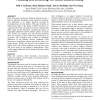Free Online Productivity Tools
i2Speak
i2Symbol
i2OCR
iTex2Img
iWeb2Print
iWeb2Shot
i2Type
iPdf2Split
iPdf2Merge
i2Bopomofo
i2Arabic
i2Style
i2Image
i2PDF
iLatex2Rtf
Sci2ools
100
Voted
CHI
2000
ACM
2000
ACM
The impact of fluid documents on reading and browsing: an observational study
Fluid Documents incorporate additional information into a page by adjusting typography using interactive animation. One application is to support hypertext browsing by providing glosses for link anchors. This paper describes an observational study of the impact of Fluid Documents on reading and browsing. The study involved six conditions that differ along several dimensions, including the degree of typographic adjustment and the distance glosses are placed from anchors. Six subjects read and answered questions about two hypertext corpora while being monitored by an eyetracker. The eyetracking data revealed no substantial differences in eye behavior between conditions. Gloss placement was significant: subjects required less time to use nearby glosses. Finally, the reaction to the conditions was highly varied, with several conditions receiving both a best and worst rating on the subjective questionnaires. These results suggest implications for the design of dynamic reading environments....
| Added | 01 Aug 2010 |
| Updated | 01 Aug 2010 |
| Type | Conference |
| Year | 2000 |
| Where | CHI |
| Authors | Polle Zellweger, Susan Harkness Regli, Jock D. Mackinlay, Bay-Wei Chang |
Comments (0)

